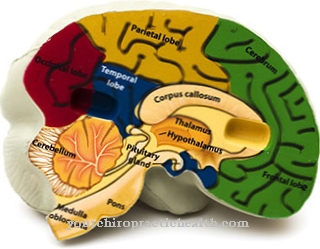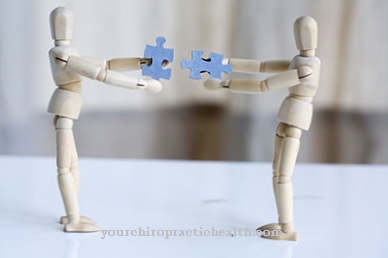Patient with Schnitzler syndrome suffer from chronic hives, bone pain and an increase in monoclonal antibodies in the gamma fraction. A causal therapy for the autoimmune disease does not yet exist because the etiology is unknown. PUVA therapy has proven itself against hives.
What is Schnitzler Syndrome?

© rumruay - stock.adobe.com
The Schnitzler syndrome is a rare and so far underdiagnosed disease that was named after the French dermatologist L. Schnitzler. He became the first person to describe the disease in 1972. Hardly a few hundred cases have been known since the discovery. On average, the disease occurs most frequently after the age of 50. In the past, there have rarely been those under the age of 35.
Schnitzler syndrome is characterized by chronic hives and a pathological increase in monoclonal antibodies in the gamma fraction of blood proteins. Monoclonal antibodies have an identical molecular structure and specialize in the same determinant of the specific antigen.
In view of its rarity, Schnitzler syndrome has not yet been conclusively researched. The majority of all research results come from recent research and relate to only about 100 known cases. Because of this research situation, all connections to Schnitzler syndrome are to be rated as rather uncertain.
causes
The current research results on Schnitzler syndrome suggest an autoimmunological etiology. However, the causal relationship has not been conclusively researched. The research is based on the suggestion of the autoimmune disease mainly on the monoclonal antibodies of the gamma fraction, which were previously detectable in all patients.
Little is known about the aetiology of autoimmune diseases. A faulty programming of the immune system is considered to be the cause of the disease group. Which primary cause of Schnitzler syndrome triggers the outbreak of the disease remains in the dark. Certain viral infections should be considered, for example.
However, no common previous illnesses could be identified in the cases examined so far. Due to the small number of known cases, research into the cause will probably take years or even decades.
Symptoms, ailments & signs
The first symptoms of Schnitzler syndrome come from the area of urticaria. In almost half of the early phase without itching, but it can become itchy as the disease progresses. Periodic fever and weight loss dominate the picture. The same goes for arthralgia. The hives mainly occur on the trunk, arms and legs. Usually the palms, soles, head and neck are not affected by the lesions.
Angioedema and bone pain have also been reported in some patients. Lymph node swelling, hepatosplenomegaly and fatigue can also develop. The spleen and liver are enlarged in some patients. The Schnitzler syndrome is chronic and can result in systemic amyloidosis.
In addition, more than ten percent of the cases develop lymphoproliferative diseases such as lymphoma or Waldenström's disease. It usually takes ten or even twenty years for these complications to occur.
Diagnosis & course of disease
The dermatologist diagnoses Schnitzler syndrome on the basis of clinical and laboratory tests. Immunoelectrophoresis shows monoclonal gammopathy. In addition, the ESR can be greatly increased. Irregularities such as leukocytosis, thrombocytosis or anemia can be observed in the blood count. In terms of differential diagnosis, adult Still syndrome should be considered in particular.
Lymphomas, cryoglobulinemia, or systemic lupus erythematosus should also be considered in the differential diagnosis. The same goes for Quincke's edema, hyper-IgD syndrome, CINCA syndrome, and Muckle-Wells syndrome. So far, research has assumed a high number of unreported patients who have probably been misdiagnosed due to the large number of differential diagnoses.
The life expectancy of patients with Schnitzler syndrome is not affected. However, regular examinations are indicated in order to detect lymphoproliferative secondary diseases in good time.
Complications
Various complications can occur as a result of Schnitzler syndrome. Weight loss and secondary diseases such as hives are typical of the disease. This can be accompanied by edema, bone pain and swelling of the lymph nodes. Chronic fatigue rarely occurs.
When the spleen and liver are enlarged, it can cause various ailments such as persistent pain and inflammation of the organs. In more than ten percent of cases, diseases such as lymphoma or Waldenström's disease develop - complications that usually occur ten to twenty years after the disease. Chronic inflammation also carries the risk of amyloidosis, which in turn is associated with serious complications. Finally, Schnitzler syndrome increases the risk of thrombosis and bone diseases.
The therapy of this rare disease carries the risk of serious side effects and interactions. The pain relievers used can sometimes cause inflammation-related anemia. The use of antihistamines and chloroquine can lead to gastrointestinal complaints, pain in the limbs and muscles and often also to skin irritations. Itching, nausea and reddening of the skin can occur as part of PUVA therapy. Acne, skin pigmentation and inflammation of the hair follicles are very rare. Bleeding into the nail bed can also occur in rare cases.
When should you go to the doctor?
Schnitzler syndrome must always be treated by a doctor. This disease cannot heal itself, so that the person concerned is usually always dependent on medical treatment. Only through early and direct treatment can further complications be prevented.
A doctor should be consulted if the patient has very severe itching. It is not uncommon for a fever and a significant loss of weight to occur. If these complaints occur without a specific reason, a doctor must be consulted immediately. Furthermore, severe pain in the bones or general tiredness and fatigue often indicate Schnitzler's syndrome and must also be examined by a doctor.
In the case of Schnitzler syndrome, the family doctor can be seen. Further treatment is then carried out by a respective specialist, although complete healing is usually not possible. Since Schnitzler syndrome can also lead to psychological complaints or depression, a psychologist should also be consulted.
Therapy & Treatment
The therapy of Schnitzler syndrome turns out to be just as difficult as the diagnosis. Since the causes have not been conclusively clarified, no causal therapy is available. Only symptomatic therapies can be implemented. Symptomatic treatment can also be difficult. Hives in particular are difficult to treat because NSAIDs are short-lived or ineffective for patients.
The same goes for antihistamines, hydrochloroquine or chloroquine. So far, patients have been given glucocorticoids, immunoglobulins and plasmapheresis on an experimental basis. However, these measures have not proven to be effective against hives either. Only PUVA therapy has proven to be the solution in some cases. Treatment is easier for intermittent fever attacks and bone pain.
NSAIDs are suitable for therapy in this context. Inflammatory anemia sometimes presents as a complication of treatment. In the past, however, patients with this complication could be treated successfully with glucocorticoids. In individual cases of illness, the patients were given interleukin-1 antagonists. This treatment has proven to be effective in individual cases. In addition to treatment, patient monitoring is an important preventive step.
Complications such as lymphoma should be treated as soon as possible. Patients with Schnitzler syndrome are therefore called upon to monitor their own course of the disease carefully and to contact a doctor if complications are suspected. Although Schnitzler's patient died of a complication of the syndrome during the first description, the lives of today's patients are not in immediate danger thanks to medical advances.
You can find your medication here
➔ Medicines to strengthen the defense and immune systemprevention
The causes of Schnitzler syndrome are still unknown. The same is true for just about any other autoimmune disease. For this reason, the syndrome can hardly be prevented in view of the research situation.
Aftercare
Aftercare for Schnitzler syndrome focuses on treating the characteristic symptoms. As a rule, the severity and its duration vary. Typical symptoms of Schnitzler's syndrome are chronic urticaria (hives), bone and muscle pain, joint pain, fever attacks, fatigue and eye infections.
Symptoms that have emerged can usually be alleviated by anti-inflammatory drugs (diclofenac, ibuprofen) or high doses of cortisone. However, prolonged use of cortisone can lead to serious side effects. After the clinical stay, regular visits to a doctor are recommended for routine diagnostics. The clinical findings should be continuously monitored during follow-up.
Blood tests are required every three months. For follow-up care for Schnitzler syndrome in general, the consumption of certain foods has no influence on the course of symptoms. In summer the symptoms can be less pronounced than in winter. In individual cases, the effects of the inflammatory substance interleukin-1 can be inhibited with medication.
The typical symptoms then remain away. Another task of follow-up care is to identify diseases resulting from Schnitzler syndrome at an early stage. So there can be a risk of amyloidosis. It cannot be ruled out that the hematopoietic system becomes ill (lymphoma). Schnitzler syndrome must be treated for life.
You can do that yourself
In Schnitzler syndrome, the most important self-help measure is to protect the affected joints and to change your lifestyle accordingly. The affected persons should be intensively instructed in the necessary measures by a specialist before starting therapy.
In the case of persistent skin changes, home remedies or homeopathic remedies may also be useful. The patient should consult with the family doctor, who can provide further measures against itching, redness and bleeding. The stability of the bones and joints can be improved by suitable physiotherapy measures. The patient should contact a physical therapist and, if possible, practice independently at home.
Rapid treatment in the hospital is required for serious complications such as AA amyloidosis. It is best for relatives to consult the medical emergency service so that the necessary countermeasures can be taken immediately. Emergency medication may be given. The doctor's primary task is to check the injection sites. If inflammation or other complaints occur here, further treatment is required. In the event of other unusual symptoms, the doctor must be informed.


.jpg)









.jpg)



.jpg)










.jpg)
